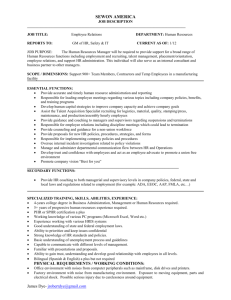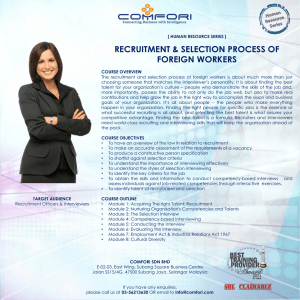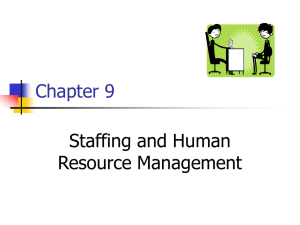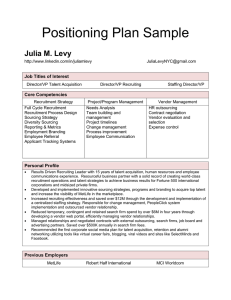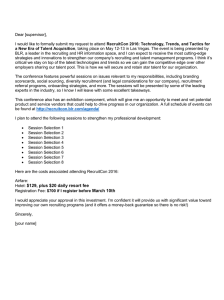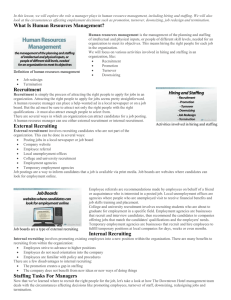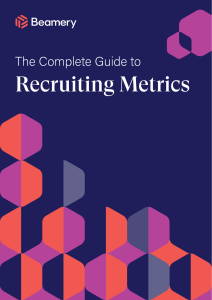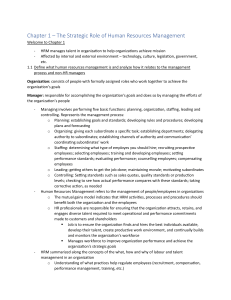9. Staffing and Human Resource Management.
advertisement
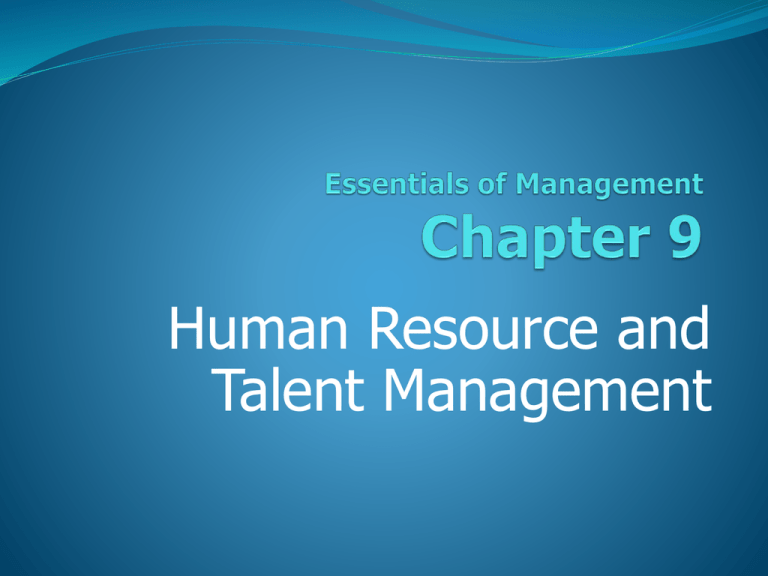
Human Resource and Talent Management Human Resource Management and Business Strategy HR professional is now partner in helping company attain its business strategy. HRM needed to help company attain high-level goals such as competing globally. HRM helps build high-performance work practices. High-performance work practices can boost organizational performance by 20%. The Talent Management Model and Strategic HR Planning 1. 2. 3. 4. 5. 6. 7. Awareness of legal aspects Human resources planning Recruitment Selection Orientation, training, and development Compensation Performance evaluation Talent Management Model, continued Employee retention is major strategy of talent management. Main reasons for turnover are individual, environmental, and workplace factors. Job embeddedness theory suggests that many factors influence turnover. Turnover created by job itself and off-the-job factors such as family commitments. Legal Aspects of Staffing Federal, state, and local laws influence every aspect of talent management. Manager should review relevant legislation and confer with company employment law specialist (should problem arise). Affirmative action programs help implement employment discrimination law. Affirmative action aims to help employees discriminated against in the past. Legal Aspects of Staffing, continued Illegal to discriminate in any aspect of employment under Title VII, the ADA, and the ADEA. Example of discrimination is harassment on the basis of race, color, religion, sex, national origin, disability, or age. Interpretation required to decide if given employee is subject of discrimination. Strategic Human Resource and Talent Management Planning Staffing begins with strategic human resources planning to support strategy. Four basic steps in strategic human resource planning are planning for (1) future needs, (2) future turnover, (3) recruitment, selection, and layoffs, and (4) training and development. Recruitment and selection can be for internal or external people. Recruitment Preferred method is to narrow down large number of candidates to a few. Searches for a good person-organization fit, and sells firm to high-quality prospects. Job description explains what jobholder is supposed to do. Job specification states personal characteristics needed to perform the job. Recruiting Sources Present employees qualified for new job Referrals by present employees Online recruiting sources including company Websites and social media sites. External sources other than online, such as recruiting ads. Some recruiters scan social networking sites in search of talented workers. Global Recruiting Multinational businesses must connect with other parts of globe to locate talent. Recruiters must meet specifications calling for multiculturalism plus traditional skills. Global recruiting for managers can be difficult because candidates are needed who can blend the work practices of two cultures. Selection: Preliminary Screening Interview Brief screening interview helps determine if candidate is plausible. Typically conducted over the telephone. “Knockout” questions used to quickly disqualify candidates (e.g., ask bus driver candidates if they sleep on the job). Webcams can also be used for preliminary screening. Types of Psychological and Personnel Tests Most commonly used types are (a) situational judgment or simulation (b) aptitude, (c) personality including emotional intelligence, and (d) honesty and integrity. Selection instruments must be validated, job-related, and non-discriminatory. Cognitive intelligence, conscientiousness the best predictors of job success. The Job Interview More valid when interviewer is trained and experienced. Realistic job preview explains potential negative features in the job. Exhibit 9.6 (text) presents guidelines for conducting productive job interview. Behavioral job interview focuses on actual job behaviors relevant to job in question. Reference Checking and Background Investigation Reference check usually focuses on past job performance and getting along with coworkers. Violent behavior inquiries often made. Background investigations focus on information other than from employers. Candidate’s credit history often checked. 50% of candidates enhance job history. Physical Examination and Drug Testing Physical exam gives indication of candidate’s ability to handle job. Exam helpful for later comparisons if worker claims job injury. Many companies test all applicants for use of illegal drugs. Overuse of prescription drugs also a problem. Drug abusers can create many problems on the job. Cross-Cultural Selection Job interviewers need to know key facts about other cultures such as differences among various schools. Some principles of selection apply across cultures, some do not apply. A key challenge is to select workers who will fit well as expatriates. Two key factors are desire for assignment, and matching candidate’s style to the new culture. Employee Orientation (Onboarding) Formally acquaints new employee with the company, explains corporate culture. Conveys specific nature of job and expectations in terms of performance. Buddy or mentor might help with orientation. Informal socialization also helps introduce new employee to corporate culture. Employee Training and Development Fosters and enhances employee learning, and aimed at acquiring job skills. Aimed at hard (technical, scientific, and numerical) skills, and soft skills (interpersonal skills and attitudes). Substantial amount of employee training now conducted by e-learning. Yet, not best for interpersonal skills, and many students still need classroom interaction. Employee Training and Development, continued. Development consists of enhancing knowledge and skills of a complex and unstructured nature. Managers as life-long learners is an aspect of development. Conducting training and development programs begins with needs assessment. Informal learning (outside of classroom) also contributes to training, development. Performance Evaluation (or Appraisal) Major components of performance are task, citizenship, and counterproductive. Forced ranking measures employees against each other, such as Top 20%, Vital 70%, and Bottom 10%. In 360-degree feedback person is evaluated by work associates. Results more often used for development than appraisal. Purposes of Performance Evaluation a. b. c. d. Serve a number of important administrative and leadership purposes. Salary administration Documenting poor performance for purposes of dismissal Increasing productivity Helping employees grow and develop Design of the Performance-Evaluation System Can measure traits, behavior, or results. Traits are stable, related to personality. Behavior is what people do on the job. Results are objectives people attain. Performance evaluation disliked by many managers and workers who are evaluated. Alternative is frequent face-to-face discussions about performance. Compensation: Types of Pay Wages and salary most common types. Bonus is reward for good performance. Job evaluation determines how much a job should receive in wages or pay. Variable pay bases part of compensation on performance. With stack ranking, employees in unit are ranked and compensated accordingly. Employee Benefits Benefits are noncash worker payments. Benefits average 35% of salaries. Companies have cut back on benefits; ask employees to pay higher share of medical benefits. With consumer driven health plans employees have larger deductibles. 401(k) plans have replaced most pensions with guaranteed monthly payments. Role of Labor Unions in HRM Labor union influences almost all human resource programs and practices. Labor union seeks fair treatment of workers in most aspects of employment. About 12.3% of workers unionized (37.4% for government workers, 7.2% private). Concern is that union has inflexible rules. Many healthy management and labor partnerships exist—including Ford.


